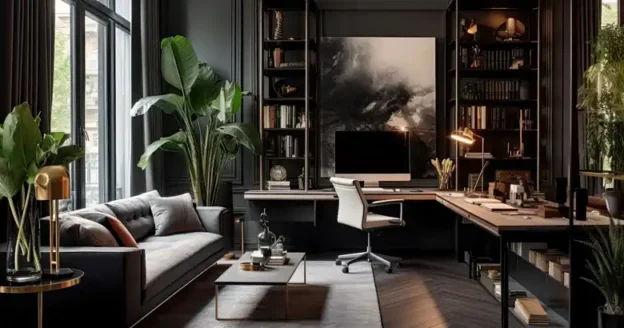Office interiors play a critical role in shaping how efficiently projects are managed and executed. A well-designed workspace can significantly enhance productivity and streamline project management processes. Here’s a look at how thoughtful office interior design can impact project management efficiency and contribute to the successful completion of projects.
1. Streamlined Workflow and Layout A strategic office layout optimizes workflow and reduces time spent on tasks. By organizing workstations, meeting rooms, and collaborative spaces thoughtfully, project managers can ensure that team members have easy access to the resources they need. An open layout with clearly defined zones for different activities can minimize bottlenecks and streamline project execution.
2. Enhanced Collaboration and Communication Effective project management often requires seamless communication and collaboration among team members. Office interiors that include dedicated collaboration areas, such as brainstorming rooms or informal meeting spaces, facilitate better interaction and idea sharing. Incorporating writable surfaces, video conferencing equipment, and comfortable seating can enhance the effectiveness of team discussions and decision-making.
3. Improved Focus and Concentration Design elements that promote a focused work environment can boost productivity. Ergonomic furniture, adequate lighting, and soundproofing features help minimize distractions and create a conducive atmosphere for concentrated work. A well-designed workspace reduces noise levels and visual clutter, allowing team members to maintain focus and complete tasks efficiently.
4. Optimized Meeting Spaces Project management often involves frequent meetings and updates. Designing versatile meeting spaces with flexible seating arrangements, built-in technology, and easy-to-use presentation tools can make meetings more productive. Quick access to these spaces ensures that project discussions are timely and effective, contributing to better project outcomes.
5. Support for Remote and Hybrid Work With the rise of remote and hybrid work models, office interiors should accommodate both in-office and remote team members. Design features such as hot-desking, video conferencing setups, and collaborative technology support seamless integration between remote and on-site staff. This flexibility ensures that all team members can contribute effectively, regardless of their location.
6. Encouragement of Employee Well-being A healthy work environment is crucial for maintaining high productivity levels. Incorporating elements such as natural light, indoor plants, and comfortable break areas into office design contributes to employee well-being. When team members feel comfortable and supported, they are more likely to be engaged and productive, positively impacting project management efficiency.
7. Efficient Use of Technology Integrating technology into office interiors can enhance project management processes. Smart office systems, such as automated lighting, climate control, and digital task management tools, streamline administrative tasks and improve overall efficiency. Ensuring that technology is seamlessly incorporated into the workspace helps team members stay organized and focused on their projects.
8. Flexibility and Adaptability Project requirements can change rapidly, and office interiors should be adaptable to evolving needs. Furniture that can be easily rearranged, modular workstations, and multi-purpose spaces allow for quick adjustments based on project demands. This flexibility ensures that the workspace can accommodate different team sizes and project phases, maintaining productivity throughout.
9. Facilitation of Knowledge Sharing Office interiors that encourage knowledge sharing and learning contribute to more effective project management. Design elements such as shared resource libraries, knowledge walls, and collaborative workstations foster an environment where team members can easily access and exchange information. This accessibility enhances decision-making and problem-solving capabilities.
10. Aesthetic and Motivational Impact The visual appeal of an office can influence morale and motivation. A well-designed, aesthetically pleasing environment can inspire creativity and a positive work attitude. Incorporating elements such as motivational artwork, vibrant colors, and comfortable furniture creates an inviting space that boosts employee motivation and contributes to project success.
In summary, office interiors have a profound impact on project management efficiency. By focusing on layout, collaboration, focus, and well-being, organizations can create workspaces that support effective project execution and contribute to overall productivity. Thoughtful office design not only enhances the work environment but also aligns with project management goals, ensuring that projects are completed efficiently and successfully.
